Imagine there are two T-shirt companies. Their shirts are both handcrafted and are of the exact same quality and style.
T-shirt seller A has never created a marketing plan and strictly relies on word of mouth to sell their shirts.
T-shirt seller B has put plenty of time into its marketing efforts. They’ve created a website, uses a variety of digital tools, posted regularly on social media, and even built an email list.
Which company do you think sells more shirts?
Regardless of the size of your company, the core marketing principles are the same. Even if you have a small business, you can create a marketing plan to help you grow your business. In fact, the smaller your business is, the more important it is to put time and energy into creating a marketing roadmap.
In this in-depth guide, we’ll cover everything you need to know about creating a small business marketing plan to help you reach your goals. We’ll break down the nine simple steps you need to take to craft a marketing plan that works in the digital age. Plus, you’ll get a template you can follow to craft your own strategy and some best practices to follow to ensure it’s a success.
What Is Small Business Marketing?
Small business marketing is the process small businesses use to get their products and services in front of potential customers to generate sales. This type of marketing typically includes a variety of marketing channels, disciplines, and tactics to gain exposure.
The primary goal of small business marketing is to not only connect with new prospects to acquire new customers but also to build and nurture relationships with existing customers to keep them coming back.
Small business marketing can consist of a variety of offline and online strategies. Regardless of the marketing tactics you use, the end goal is typically to generate more revenue, expand market share, improve profitability, and grow.
What Is a Small Business Marketing Plan?
A small business marketing plan is a roadmap small businesses can use to reach their marketing objectives, increase revenue, and grow their overall business. A small business can use a marketing plan to guide their entire marketing efforts to ensure they meet their company’s objectives.
In 2021, the most prominent small business marketing challenges were:
- Not having enough time and resources to focus on marketing
- A small marketing budget, and
- Lack of clear marketing strategy and objectives
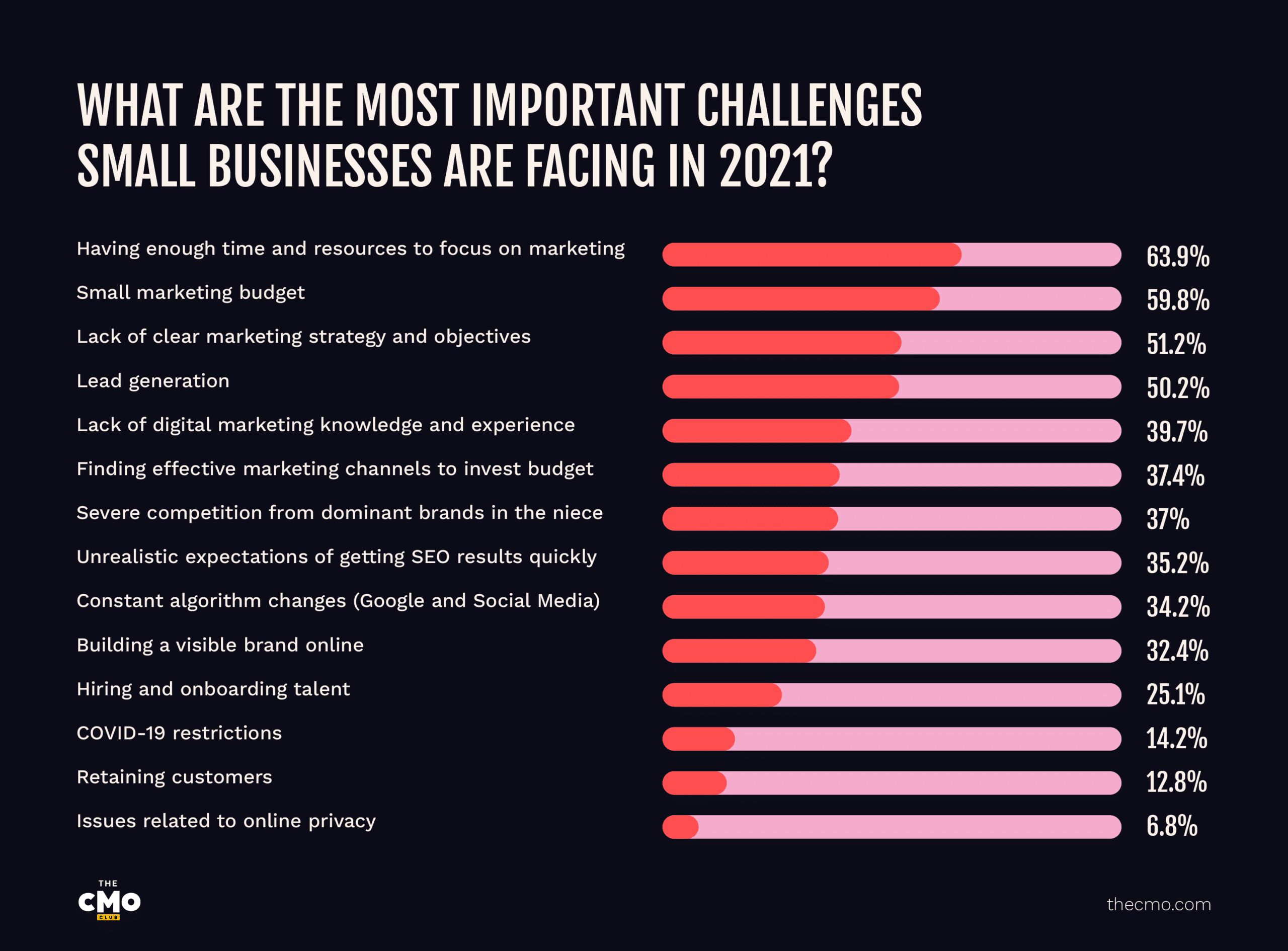
Without a clear marketing strategy and objective, your marketing efforts will be a waste. But, if you implement a small business marketing plan, you’ll be well to see your company or department succeed.
9 Steps to Create a Small Business Marketing Plan
Every small business marketing plan will be different as each business is different. But there’s a simple framework you can use to come up with a plan that’s actionable and effective. Follow these nine steps to set your marketing team up for success:
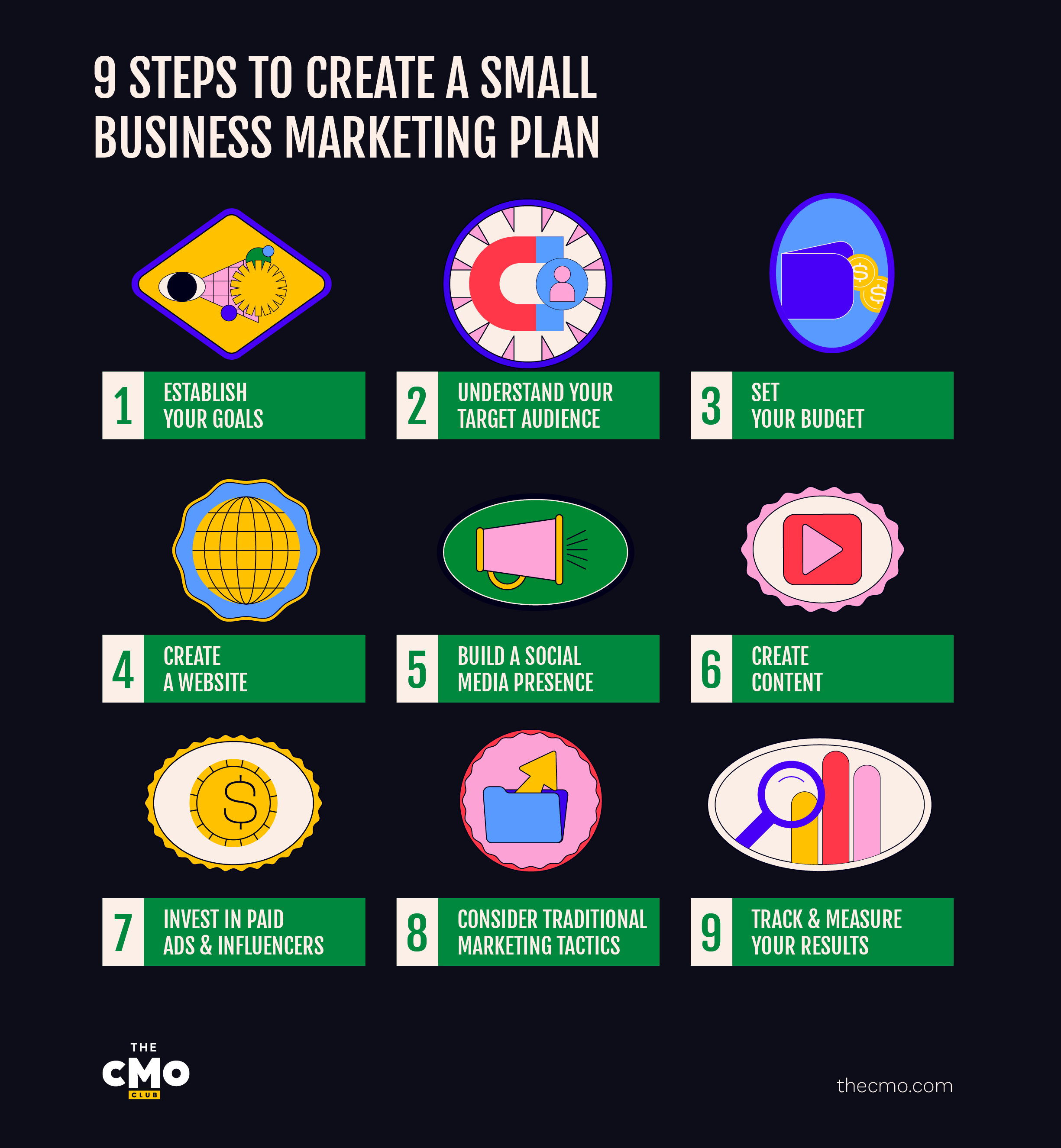
1. Establish your goals
First off, you need to set your marketing goals. But you can’t just set a random, vague goal like “Make more money.” You need to set clear, actionable goals.
The best way to come up with marketing goals is to use the “SMART” formula. This stands for:
- S: Specific
- M: Measurable
- A: Achievable
- R: Relevant
- T: Time-bound
The SMART goal strategy is a tried and true method of goal setting to help you achieve what you’re aiming for. Here’s an example of a SMART small business marketing goal:
“Increase return customer rate from 5% to 20% in 12 months.”
Let’s see how it lines up with the SMART formula:
- S: Specific (about retention)
- M: Measurable (includes real numbers)
- A: Achievable (not too far out of reach)
- R: Relevant (aligns with your overall business objectives)
- T: Time-specific (in 12 months)
If you’re having trouble coming up with your goals, you could start by identifying some broader small business objectives before getting specific.
Here are a few common small business marketing goals:
- Build a greater online presence
- Generate more leads (and customers)
- Increase brand awareness
- Connect with a broader audience
- Engage with your audience more
- Generate more recurring revenue
It’s up to you to figure out which of these goals makes the most sense for your team and your business. Try and come up with 3-5 SMART goals now and write them down.
2. Understand your target audience
Now that you’ve established your primary marketing goals, it’s time to focus on your audience. Ultimately, they’re going to be the ones to help you reach your goals.
Before you can achieve any sort of success with your marketing efforts, you need to know who you’re targeting. Your target audience can vary based on a variety of different factors like geographical region, your business type, and demographics.
Oftentimes, your audience will dictate the type of marketing tactics you implement later on, so it’s crucial you take the time to research so you can understand them better.
For instance, if your target audience is in their 70s, then TikTok might not be the best place to invest your marketing resources. On the other hand, if you’re targeting Gen-Zs, then you should probably avoid print ads and, instead, get on TikTok and Instagram asap.
Here are a few questions you should ask yourself to help understand your audience:
- Who are your past customers? Look at demographics like age, location, and gender.
- Who are your returning customers? This is important to understand, especially if one of your goals is to generate recurring revenue through increased retention.
- Who do you want to reach? While you may have a specific past customer base, it’s crucial to know the type of customer you’re after so you can adjust your marketing strategy to target them better.
- What products or services are people buying from you the most? Look at sales data to help understand what your customers are interested in, their pain points, and the problems they’re looking to solve.
- Why did your past customers buy from you? Look into primary driving factors for their purchase decisions. You can email customers directly, conduct surveys, and look at reviews and testimonials to understand the intent behind their purchases.
3. Set your budget
Now that you’ve set your goals and understand your target audience, it’s time to establish your marketing budget.
You should take the time to assess the current financial health of your business—including your current and future cash flow—to determine your marketing budget. If you’re not running the finances in your small business, sit down with your CFO to come up with a budget you can both work within.
It’s crucial to figure out your budget ahead of time, as it’ll help guide the remainder of your marketing plan.
You should be realistic about how much money you’re able to invest into your marketing efforts every month.
If you’re scratching your head wondering where to start, you can start with around 10-20% of your overall revenue. This is a typical budget allocation for small businesses to invest in their marketing efforts.
While this may seem like a lot to invest, the return on investment (ROI) will be well worth it (if you implement the right marketing plan).
If you’re thinking you have almost nothing to spend on marketing as you’re brand new, that’s alright! Any little bit helps. Whatever you can invest in your marketing will help fuel future business growth.
Don’t forget that when budgeting, you should also take into consideration your time budget. In other words, you should look at not just the money you can put into marketing but the overall resources, including work hours. How much time are you able to devote to your marketing strategy every day, week, or month?
Write it down alongside your monetary budget. It can be easy to let other business activities take priority over your marketing efforts. Make sure you craft a time budget as well to ensure your marketing gets done. This will help you see your goals through to the end.
4. Create a website
Now that you’ve set your time and money budget, it’s time to spend it!
This is the fun part (at least for most people). Now that you know what you’re working with in terms of your resources, you can get to work on your marketing.
Your website is the digital headquarters for your business. It’s the place where you establish your branding, where you convert prospects into leads, and where you generate new sales.
You need to ensure your website is both professional and tactical. It’s the place where you show off who you are and what you offer. It’s the place of first impressions, so you need to ensure it’s designed well and functions in alignment with your goals.
The most effective websites will be much more than a digital brochure. When crafted properly, they can be 24/7 salespeople for your business.
If you have the budget, you should hire a web designer and developer to help you craft a professional site. If you have a limited budget, there are plenty of cheap and free website-building tools you can use to create your own site, even if you know nothing about design or coding.
5. Build a social media presence
Now that your headquarters is established, it’s time to set your brand up on social media. Nowadays, social media is an essential part of any small business marketing plan (whether your business is online or offline). The reality is that every type of customer is on social media (regardless of age).
If your audience skews younger, then chances are they’re on TikTok, Instagram, and Snapchat. If they’re older, they’re likely on Facebook. If you have a B2B brand, then you might want to check out LinkedIn.
You probably think all the different platform choices are overwhelming. You’re right—it can definitely be a confusing process trying to figure out how you’ll manage to post on dozens of social platforms consistently.
The truth is, you don’t have to, and you shouldn’t—at least not at the start.
The best way you can get started with your social media plan is to focus on one platform (two at max) when you’re first starting out. Take a look back at number two—your audience. Where are they? Chances are, they hang out on one social media platform more than the others. Try to determine where they hang out. If you’re unsure, you can conduct surveys, ask customers one-on-one, or you can try testing out paid ads on a few platforms to see if there’s a winner early on (we’ll touch more on this at number 7).
There are two secrets to winning with social media:
- Post consistently.
- Engage with your followers.
That’s it. Yes, there are dozens of other tactics you can use to increase your social media marketing efforts. But you should spend 80% of your social media efforts focusing on these two things—especially when first starting out.
Just remember: Even if you’re not going to start posting regularly on all the additional social media platforms, it’s important that you at least make a profile on each one to establish consistent branding if you do decide to branch out to them in the future.
6. Create content
Ever heard the term content marketing? It’s one of the most powerful forms of digital marketing in 2023. While content marketing primarily refers to blog posts and articles that help drive traffic to websites, it encompasses a wide variety of different mediums and content types.
In 2021, video content actually surpassed blog content in terms of the type of content created in content marketing strategies.

Businesses primarily use content marketing as part of an overall inbound marketing strategy—which includes creating content as a means to draw people to your site. Inbound marketing is all about providing your potential customers with helpful information and resources and providing value that both attracts and converts them into customers.
Nowadays, your content marketing strategy can include a variety of content types:
- Social media marketing
- Video content
- Blog posts and articles
- Audio
Similar to choosing a social media platform, it can be confusing where to start with content types. You should consider two things: the ways your audience consumes content and the content you like producing.
For instance, you may find that your audience loves video content the best, and they hang out on YouTube and Instagram. But you’re really not into creating long-form videos. Instead, you could create stories on YouTube and Instagram—short-form videos you like creating that also engage your audience.
Just remember, it’s more important to consider how your audience likes consuming content than what you actually enjoy creating. If you despise writing but you know your audience loves reading blogs, then you may want to outsource your content writing or hire a content agency to help you create content.
7. Invest in paid ads & influencers
All the marketing tactics we’ve mentioned above so far are primarily longer-term tactics to grow your audience and build a brand for the long haul.
However, there are two primary marketing tactics you can use to grow your audience and convert customers quickly—if you have the budget.
Those two are paid ads and influencers.
With enough money, you can access any audience. This could be paying for Facebook ads, or it could be paying an influencer to review your product to their audience of 300,000 engaged followers.
Either way, if your goal is to grow or convert new customers quickly, then you can leverage paid ads, influencers, or a combination of the two to reach your goals. To get started, you don’t need to have tens of thousands to spend. With even the smallest of budgets, you can focus on micro-influencers and run pay-per-click ads on Google or Instagram.
8. Consider traditional marketing tactics
The world, in 2023, is super digital. Everyone has a digital marketing strategy. You can use that to your advantage. As digital marketing has become the dominant form of marketing over traditional efforts, traditional marketing has become less expensive and less crowded.
A well-rounded small business plan will often include both online and offline marketing strategies. If you want to diversify your marketing efforts, then you may want to consider implementing some traditional tactics as well, such as:
- Print advertising
- Flyers
- Billboards
- Brochures
- Events
- Workshops
If you have a business that’s primarily targeting a local audience, then you will definitely want to consider some of these tactics. These traditional marketing efforts can be incredibly powerful for community and brand-building. If you have a brick-and-mortar store, then implementing at least a few of them is essential to thriving in your community.
9. Track & measure your results
Now that you’re taking action and working on the different marketing tactics outlined in this comprehensive plan, it’s time to focus on perhaps the most important step of them all: tracking and measuring your results.
This is a critical step—and one that will essentially evaluate how close you are to your targets set in step number one. Did you reach your goals? Did you surpass them? Did you fall short?
If you want to succeed with your marketing plan, you need to analyze your efforts. You may be posting on Facebook every day only to get a couple of likes here and there. Or maybe you've built a blog that’s generating thousands of visitors every month.
Perhaps your in-person workshops have turned into a thriving repeat customer base.
You should go back to your original goals at the end dates you set for them (since you crafted SMART goals). Where did you land? If you didn’t reach your goal, analyze why. What tactics and specific steps of action did you take (or not take).
What channels are serving you the most?
What channels are performing the worst?
The best way to close out step nine is to re-establish new goals and essentially start your marketing plan over again. Except this time, you’re not starting from scratch. You’ve built up a solid plan and simply need to shift course a bit. You’ve seen what’s working and what’s not, so you can allocate more time, money, and resources to improve your plan even more.
Remember, building your marketing plan isn’t a one-time event. The best small business marketers know that continually monitoring their efforts and optimizing them is how they will find success in the long term.
Small Business Marketing Plan Templates
If you’re looking for a marketing plan template, you can follow steps 1–9 above to create your roadmap. But, if you want something easy—where you can simply fill in the blanks, then there are hundreds of free or paid marketing plan templates available online.
Whether you’re looking to start from scratch with a comprehensive marketing plan template or a simple one-page template, or you want a practical project-based roadmap, there are plenty of resources available.
Comprehensive marketing plan template
Business.com created a free marketing plan template you can use built right within Google Docs. It’s a comprehensive template you can use to build your marketing plan in a day. Each section includes in-depth explanations as well as free resources to learn more so you can build a clear roadmap.
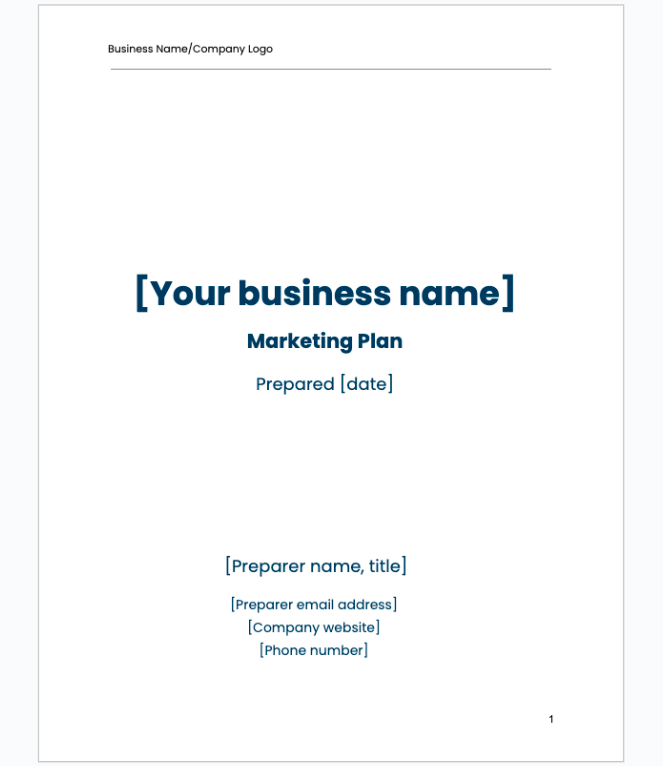
One-page marketing plan template
If you don’t have a lot of time available to work on an in-depth plan, then you’ll want to consider Smartsheet’s template. Smartsheet offers a ton of free marketing templates, including a simple one-page marketing plan that you can get done in under 30 minutes.
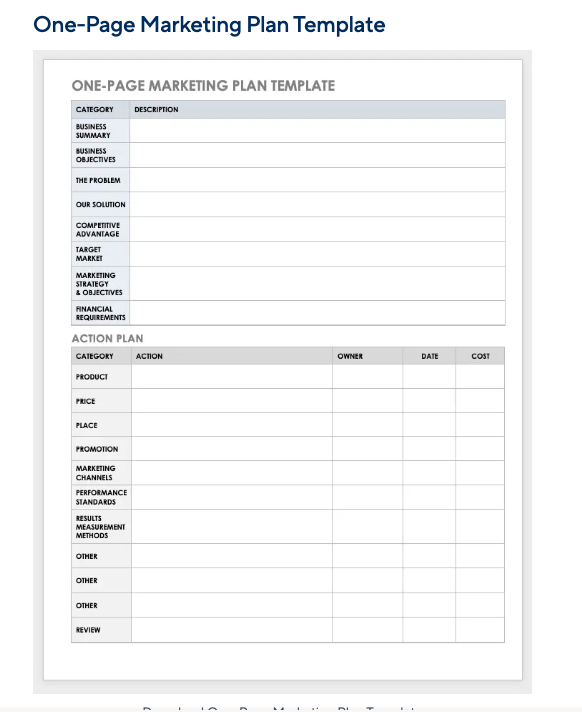
Project-based marketing plan template
If you’re looking for a template that’s more of an action plan for your upcoming campaigns, then you’ll want to check out Monday.com’s marketing plan templates. While you’ll have to get a paid plan to use Monday.com, you get access to a variety of impressive marketing plan templates that are project-based and actionable to help you meet your goals.
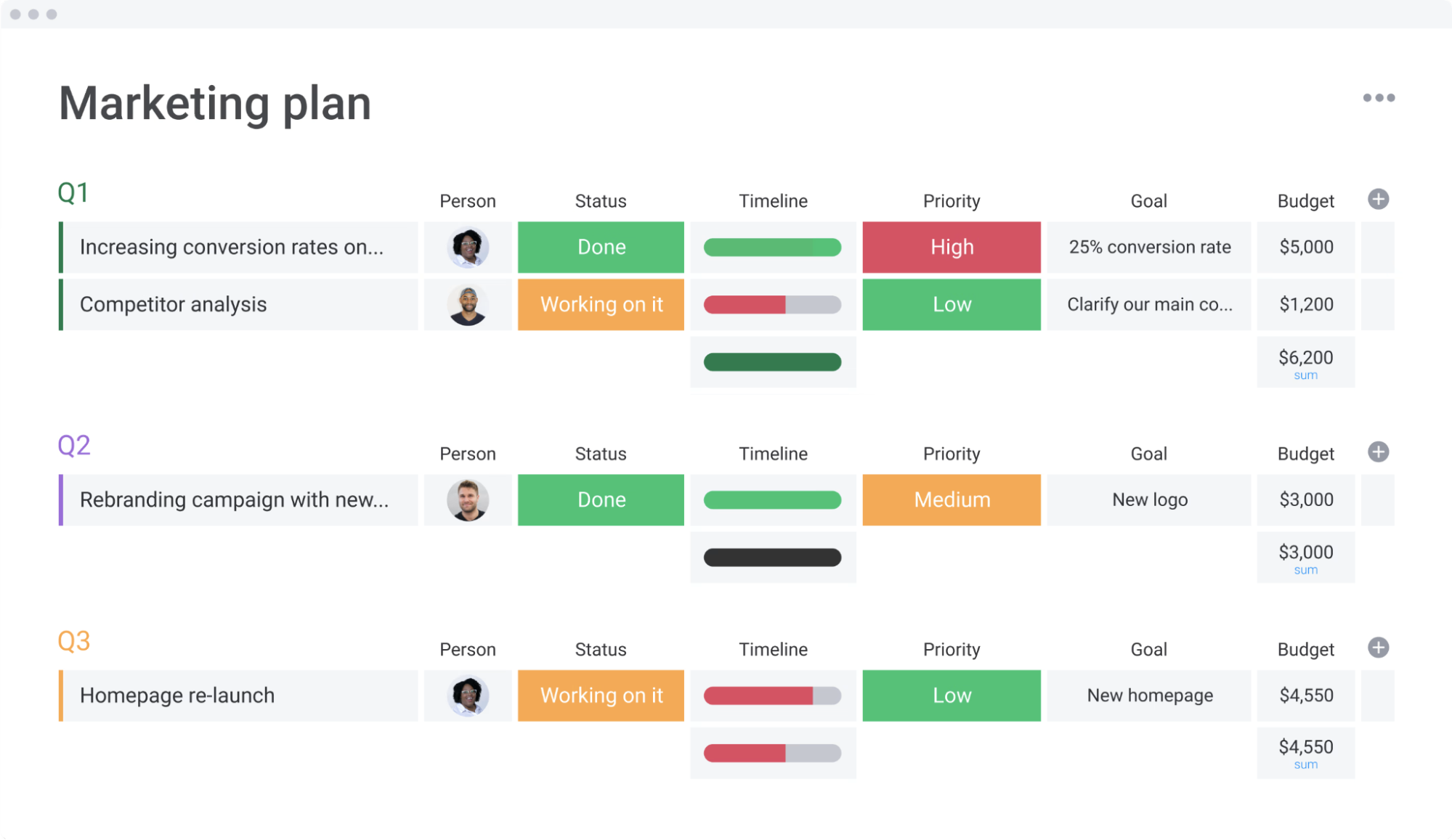
4 Best Practices When Crafting a Marketing Plan
1. Center everything around your value proposition
What makes you stand out from the crowd? Why should customers choose you over the competition?
When building your marketing plan, you always need to keep your value proposition top of mind. It has to take center stage when crafting every piece of content, creating new campaigns, and establishing your buyer personas.
Your value proposition is the thing that differentiates your brand from others in the space. If you’re not sure what yours is, try looking at what you do better than everyone else in your industry. If you can’t figure it out, then you need to establish the thing that does make you different. It could be your product, customer service, content plan, branding, or even price.
2. Stay focused on your primary goals
There are dozens of different paths you can take with your marketing. Within the marketing world, it can be easy to get distracted by new, shiny marketing tactics that are “guaranteed” to convert. While it can be tempting to give in to them, it’s best to stick to your core tactics.
Once you have your marketing plan set up, you need to stick to it to ensure the highest odds of success in reaching your goals. Once you’ve reached your primary objectives (or you’re on the trajectory to do so), then—and only then—should you even consider shifting your marketing efforts to other tactics.
3. Be consistent with your branding
Your branding is your business, and your business is your branding.
When it comes to building the right marketing plan, it’s important to measure the results of your efforts. One of the more challenging aspects of marketing success is measuring how well you are branding yourself. How powerful is your brand?
Your brand image has the power to turn customers off forever with a bad first impression or create raving fans who tell all their friends to buy from you.
One of the key elements to establishing your branding is to ensure you’re consistent. You need to know what type of brand you want to be, then ensure you’re congruent with it everywhere—on your website, social media, ads, in your voice, and even in your customer support.
4. Build a tool stack
In the digital age, you’ll only get so far with your marketing plan without the right tools. Even if you don’t consider yourself tech-savvy, you need to have the right technology at your disposal in order to make a dent with your marketing—even if you lean heavily on traditional marketing tactics.
Here are a few different types of marketing tools you should consider using:
- Marketing strategy software
- Email marketing software
- Content marketing software
- Social media software
- Project management software
- Analytics software
If you have a lean budget, don’t worry. There are plenty of tools in nearly every tool category that won’t cost you a thing.
Level Up Your Marketing Strategy
No matter how great your product or service is, you won’t be able to create consistent growth without a proper marketing plan.
Remember, marketing plans with the greatest odds of success start with the end in mind. Stay focused on your business objectives, and pay attention to what’s working. By staying flexible, you’ll be able to optimize your strategy over time and find success in your industry.
If you want to stay up to date on the latest marketing strategies and trends, then sign up for The CMO newsletter today. Our email newsletter offers practical advice and software recommendations from industry experts you can use to level up your marketing strategy and grow your business.


